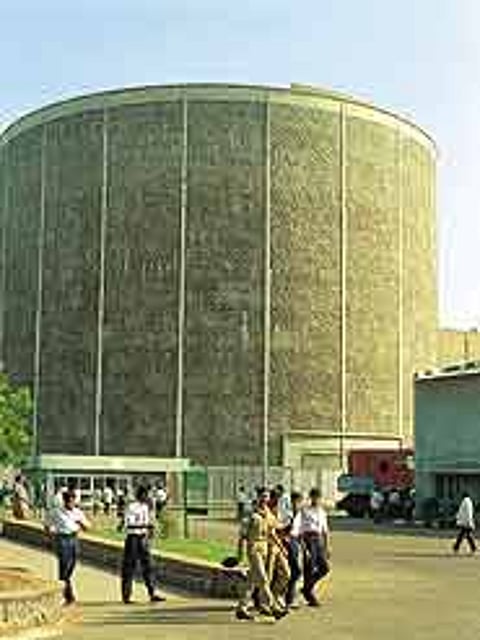DAE: Slow Reactors To Impending Doom?
Even with several nuclear reactors on coastal sites, the DAE seemed oblivious to seismic threat. The tsunami hopefully will wake them up.

The Department of Atomic Energy (DAE) had concluded with awesome confidence that tsunamis do not occur in coastal India. The Madras Atomic Power Station (MAPS) at Kalpakkam, 70 km north of Chennai, has two units of 220 MWs each, started in 1984 and 1986. Besides, the Tarapur Atomic Power Station in Maharashtra with two 160 MW units, established in 1969, is located on the west coast; so too is the entire barc establishment in Trombay. Deep down the Tamil Nadu coast, near Kanyakumari, the Koodankulam Nuclear Power Project (KNPP) involves the construction of two Russian reactors of 1,000 MW each which began in March 2002. The units will reach criticality in 2007. India’s eastern and western coastline will then be dotted with six nuclear reactors, the Tamil Nadu coast will have four of them. And still the DAE’s think-tank strongly believed that tsunamis and seiches will not occur in India.
The December 26 event must have changed this perception. However, that leaves us with reactors on the coastline not having safety devices to withstand tsunamis. It’s not that Indian scientists were unaware of the tsunami threat. Says Arun Bapat, Pune-based seismologist, who in 1987 was on a committee that looked into the potential seismic threat to the Koodankulam nuclear project: "I very clearly told the DAE that the proposed site near Kanyakumari was vulnerable to tsunami damage. They ignored my opinion." In 1999, Bapat’s paper with Tad Murty, a Canada-based tsunami expert, in the Science of Tsunami Hazards, the international journal of The Tsunami Society, Hawaii, looked at tsunamis on the Indian coastline. The paper pointed out: "No matter how rare tsunami events may be, they cannot be totally ignored in terms of public safety as well as safety of the coastal infrastructure." A map in this paper marks Koodankulam as a danger spot for tsunamis.
When the waves lashed Kalpakkam on December 26, only one of the units, MAPS-2, was operational. Seawater entered the pumphouse of MAPS. According to DAE chairman Anil Kakodkar, an underground tunnel ferries seawater to the pumphouse for cooling the reactors’s condensers. When the tsunami waves struck, there was a rise in the seawater level, and the level in the pumphouse (which is a huge well) also built up. The equipment in the control room ‘sensed’ this and the reactor shut down by itself. The DAE has ruled out a full report for now. It has been claimed that there was no casualty at MAPS. However, in the DAE residential township itself, 30 people have died. In Kalpakkam fishing village, 250 people perished.
Experts believe that though nuclear reactors are designed to be safe under seismic conditions, there are times when they are especially susceptible to earthquakes, for example, while fuel is being loaded. Says M.V. Ramana of the Centre for Interdisciplinary Studies in Environment and Development, Bangalore: "Because they are refuelled online, pressurised heavy water reactors, of which MAPS is an example, suffer from this susceptibility during a seismic event."
Official statements have focused only on the safety of the reactors. However, the complex at Kalpakkam does not include just the MAPS reactors but seven other nuclear facilities including spent fuel pools, a reprocessing plant and waste management facilities. Fears Ramana: "The water could well have entered some of these other facilities causing radioactive materials to be dispersed into the environment. Without the facilities being opened to independent assessment, it is impossible to rule out this possibility." However, the Atomic Energy Act makes it impossible for such surveys. Says R. Ramesh of Coimbatore-based Doctors for Safer Environment, "The ignorance of the DAE experts on tsunamis is shocking. Even now, they are not willing to consider shifting the Prototype Fast Breeder Reactor (PFBR) site from Kalpakkam. The present site is just 5.6 metres above mean sea level; the DAE should agree to study the probability of tsunami hazard and then decide whether it should relocate the reactor."
Tsunamis are not the only threat. Geologists have been pointing out since 1987 that the Koodankulam project is located in an area prone to seismic and volcanic activities which could destabilise the project. A 1994 paper in the Journal of Geological Society of India cites "the presence of two dormant volcanoes in the Gulf of Mannar in the Indian Ocean some 130 km southeast of Koodankulam". But of course, the DAE’s studies do not reckon with either tsunamigenic quakes or volcanic activity.
Tags